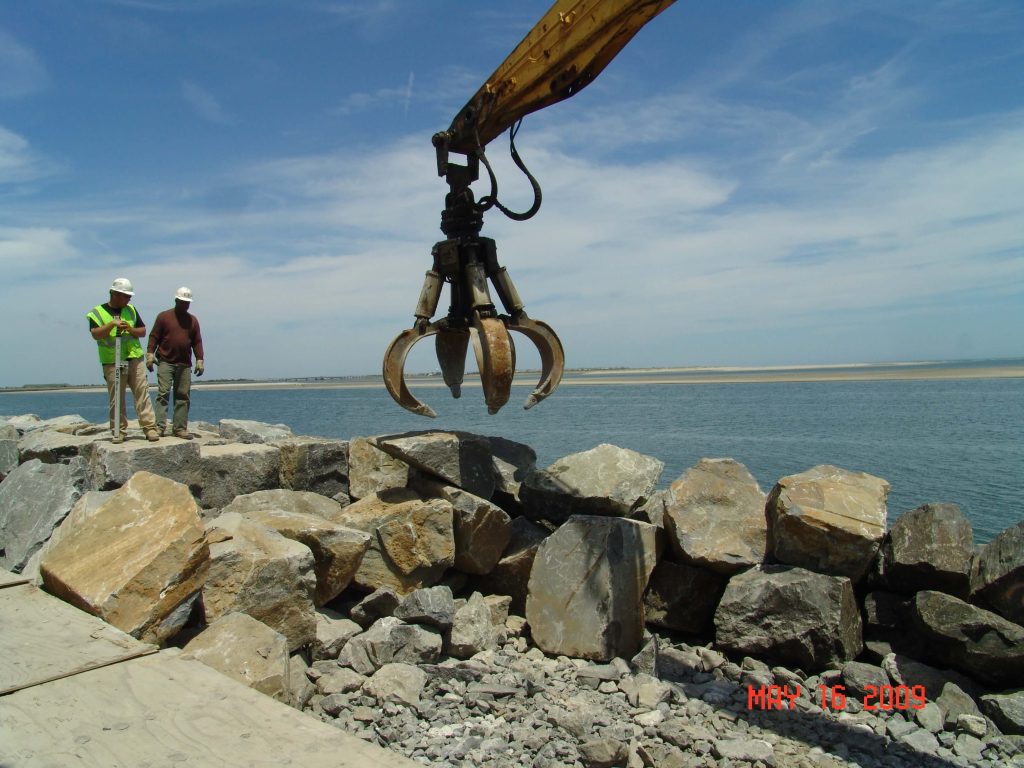NORTH WILDWOOD – The expensive, and time-consuming, process of bringing sand by the truckload to North Wildwood’s beaches may soon come to an end.
Mayor Patrick Rosenello concluded a July 19 City Council meeting by urging the governing body to think “long and hard” about spending “$4 million a year to move sand that is gone a couple of months later,” and stressed the importance of steel bulkheads to protect the city from ocean water.
The city has spent millions of dollars on back passing (the bulk movement of sand from one beach to another) but has “almost nothing to show for it,” City Administrator Nic Long said in a call with the Herald. “It’s becoming a burden.”
Long said that North Wildwood has likely “hauled more sand than anywhere else in the country.”
Back passing has become a point of contention in the city. The stockpiled sand continues to shrink, as storms, like a damaging Mother’s Day storm in May 2022, wash and blow sand away before beachgoers ever get to enjoy it.
Rosenello cautioned the council that the high costs of back passing are “bankrupting” other important city infrastructure projects.
Long said the money that goes towards back passing could instead be used to repave city streets, fund a back bay park, improve North Wildwood’s stretch of the boardwalk, “everything…”
The city’s 10-year capital plan, which would usually prioritize those projects, has been “completely upended” by the back passing efforts, Rosenello said.
Salvatore Zampirri, council president, echoed this sentiment in an email exchange with the Herald. He said that back passing “handcuffs” the city’s capital plan, adding that the city has spent over $10 million to move sand since the city began back passing.
Rosenello pointed to the ways that the project has ballooned in cost over the years.
“The sand back passing started as 100,000 cubic yards, and it cost a million dollars to do,” Rosenello said. “You start at $1 million, which quickly jumped to $3 million, and we’ve been at $3.5 million for how many years now? As we are looking at our 10-year capital plan, you plug those numbers in there, it is completely unsustainable… to move sand that is gone a couple of months later.”
The logistics became more complicated when the federal government prohibited North Wildwood from taking sand from Hereford Inlet, which is protected by the U.S. Fish and Wildlife Service. Sand is now hauled from the Wildwoods and is only increasing in cost.
A report from Dr. Stewart Farrell, a leading beach engineer out of Stockton, says that roughly 80% of the sand moved this year is already gone; 50% of it was gone after the Mother’s Day storm.
The city’s back passing was never intended to be a long-term solution to beach erosion. Long said that the U.S. Army Corps of Engineers has made promises to the city to invest in long-term solutions, like a protective dune system and the hydraulic pressing and dredging of sand. These projects are designed with resiliency in mind and are less susceptible to short-term damage from storm events.
Hurricane Sandy (2012) and Winter Storm Jonas (2016) both brought incredible damage to North Wildwood. Long said that these storms demonstrate a great need for the Army Corp’s beach projects.
Joseph Rullo, councilman for North Wildwood’s second ward, expressed similar regret in a call with the Herald that the Army Corp has not yet begun work in the city.
Rullo said that this year might be a good time to “take a break” from back passing. He said that he is “sure council will come to an agreement that’s best for everyone,” and that the issue is far from closed.
He also said that a break from back passing would give the city more money to work on beautification projects.
Nearby Stone Harbor and Avalon, both of which experience erosion problems, could get help from the Army Corp of Engineers as soon as December. Ocean City’s beaches will receive dredged sand, with help from the federal government, before 2023. However, there is no federal help in sight for North Wildwood.
“We’re still waiting on help from the federal government,” Long said.
He noted that, although help will likely come one day, there is “no actual plan” in place at present.
In the meantime, the city looks to the state to extend North Wildwood’s existing sea wall. Long said that the city hopes to extend the sea wall to Seventh Avenue if funding allows. The city hopes for state and separate federal funding to begin the project. This project, which would protect the city from storms and sea level rise on a longer timescale, could cost the city as little as $2 million, Long said.
Scott Jett, city clerk and historian, said that North Wildwood’s sea wall efforts began back in 1887 when an ordinance required property owners on Surf Avenue to protect their land with 4-foot wooden walls. These bulkheads are primitive by today’s standards but set the tone for future projects.
Small-scale bulkheads have come and gone since the late 19th century, but construction began on a proper steel bulkhead in 2005 with help from the state Department of Environmental Protection (DEP) and the Army Corps of Engineers.
Extending this existing bulkhead could be key to future protection against the ocean, Rosenello said.
“We have to be prepared going forward to project the city with a hard structure,” he added, noting that the city has filed an application with the DEP for the bulkhead’s extension.
Long said that construction on the sea wall could begin as soon as spring 2023.
Have any thoughts and/or information on this topic? Email chall@cmcherald.com.








